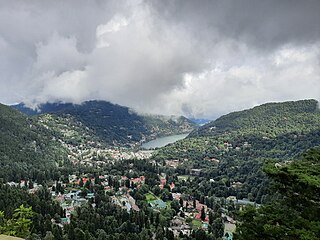
Nainital is a town and headquarters of Nainital district of Kumaon division, Uttarakhand, India. It is the judicial capital of Uttarakhand, the High Court of the state being located there and is the headquarters of an eponymous district. It also houses the Governor of Uttarakhand, who resides in the Raj Bhavan. Nainital was the summer capital of the United Provinces.
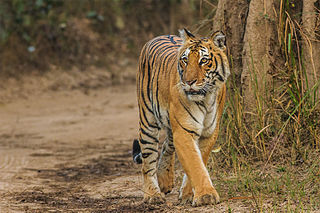
Jim Corbett National Park is a national park in India located in the Nainital district of Uttarakhand state. The first national park in India, it was established in 1936 during the British Raj and named Hailey National Park after William Malcolm Hailey, a governor of the United Provinces in which it was then located. In 1956, nearly a decade after India's independence, it was renamed Corbett National Park after the hunter and naturalist Jim Corbett, who had played a leading role in its establishment and had died the year before. The park was the first to come under the Project Tiger initiative.

Edward James Corbett was an Anglo-Indian hunter, tracker, naturalist and author. He was frequently called upon by the Government of the United Provinces of Agra and Oudh to kill man-eating tigers and leopards that were attacking people in the nearby villages of the Kumaon and Garhwal Divisions. He recounted his hunts and experiences in books like Man-Eaters of Kumaon, which enjoyed critical acclaim and commercial success. He was also an avid photographer and spoke out for the need to protect India's wildlife from extermination. In his honour, the Indochinese tiger subspecies has the scientific name Panthera tigris corbetti.

Kumaon is a revenue and administrative division in the Indian State of Uttarakhand. It spans over the eastern half of the state and is bounded on the north by Tibet, on the east by Nepal, on the south by the state of Uttar Pradesh, and on the west by Garhwal. Kumaon comprises six districts of the state: Almora, Bageshwar, Champawat, Nainital, Pithoragarh and Udham Singh Nagar.

Haldwani is the largest city of Kumaon. It is also the third most populous city in the Indian state of Uttarakhand. Haldwani is said to be the financial capital of Uttarakhand, having the most commercial, economic and industrial activities of the state. Haldwani is located in the Nainital District, and is one of its eight Subdivisions. The Haldwani Urban agglomeration has 232,060 people as of 2011, and is the third most populous UA in Uttarakhand, after Dehradun and Haridwar. Being situated in the immediate foothills of Kumaon Himalayas, the Kathgodam neighbourhood of Haldwani is known as the "Gateway to Kumaon".

Mukteshwar is a village and tourist destination in the Nainital district of Uttarakhand, India. It sits high in the Kumaon Hills at an altitude of 2171 meters (7500 feet), 51 km from Nainital, 72 km from Haldwani, and 343 km from Delhi.

Kaladhungi is a town and a nagar panchayat in Nainital district in the Indian state of Uttarakhand.

Birla Vidya Mandir in Nainital is a residential boarding school for boys in India which was founded on 17th of July 1947 just before Indian Independence. The school is mainly the product of the vision of Govind Ballabh Pant, an Indian independence activist. BVM is ranked among the TOP 5 Boys Boarding Schools in India with world class facilities and faculty. It also houses one of the world's highest altitude school playing field and swimming pool. It is located on the high peaks of the main town Nainital. It is approx 2500 m above the sea level and it's also 500 m above the main town & tourist destination Nainital which is itself approx 2000 m above sea level.

Raj Bhavan, Dehradun or Governor's House, Dehradun is the official residence of the governor of Uttarakhand. Uttarakhand is one of the few Indian states which have two official buildings of Raj Bhavans. The first one is located in the capital city of Dehradun. The second Raj Bhavan of Uttarakhand is located in Nainital. The current governor of Uttarakhand is Gurmit Singh.

Ramnagar is a town and municipal board in the Nainital district of Kumaon in the state of Uttarakhand, India. It is located approximately 65 kilometres (40 mi) from Nainital, the headquarters of the district.
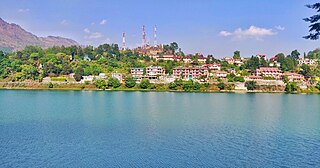
Bhimtal is a town and a nagar panchayat, near Nainital city in Nainital district in the state of Uttarakhand, India. It is situated at an altitude of 1370 meters above sea level and is about 22 kilometers from Nainital. The major attraction in Bhimtal is the Bhimtal Lake, which has an island at its centre. Besides tourism, Bhimtal has also now become a mini district headquarters since most of the district administration offices have shifted to the newly constructed Vikas Bhawan, the building complex for district administrative offices.

Uttarakhand has a total geographic area of 53,483 km2, of which 86% is mountainous and 65% is covered by forest. Most of the northern parts of the state are part of Greater Himalaya ranges, covered by the high Himalayan peaks and glaciers, while the lower foothills were densely forested till denuded by the British log merchants and later, after independence, by forest contractors. Recent efforts in reforestation, however, have been successful in restoring the situation to some extent. The unique Himalayan ecosystem plays host to many animals, plants and rare herbs. Two of India's great rivers, the Ganges and the Yamuna take birth in the glaciers of Uttarakhand, and are fed by myriad lakes, glacial melts and streams.

Naukuchiatal or "lake of nine corners" is a small hill station, near Nainital Town in Nainital district of Kumaon, Uttarakhand, India. The chairman is Devendra Singh chanotiya.
Uttarakhand is a state in the northern part of India. It is often referred to as the "Devbhoomi" due to its religious significance and numerous Hindu temples and pilgrimage sites found throughout the state. As a result, religious tourism forms a major portion of the tourism in the state. Uttarakhand is known for the natural environment of the Himalayas. 2019 Tourist Arrivals Domestic – 40,000,000 per/year and Foreigner – 150,000 per year. Tourism business in Uttarakhand generated ₹ 23,000 crores during 2013–14.
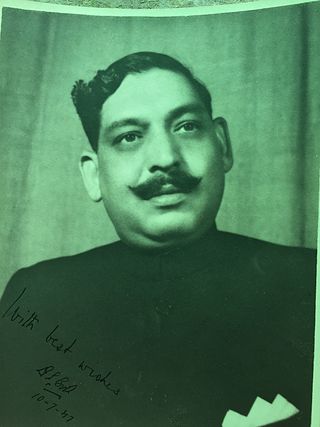
Thakur Dan Singh Bisht was a philanthropist from Kumaon, Uttarakhand, India.
William John Dwyer Burkitt was a judge in British India.

The second Raj Bhavan or Governor's House of Uttarakhand is located in Nainital, it is the summer retreat of the governor of Uttarakhand. In the pre-Independence era, Nainital served as the summer capital of United Provinces and this building, built like a Scottish castle was christened as the "Government House". Raj Bhavan was built by the British as the residence of the governor of the North-Western Provinces. The beginning of construction of Raj Bhavan started in April 1897 and took two years to complete. It is built on European pattern and based on Gothic architecture. The designers of Raj Bhavan at Nainital were Architect Stevens and the Executive Engineer F. O. W. Ortel. After independence it was renamed as Raj Bhavan.

St. John in the wilderness is an Anglican church in India and one of Nainital's oldest buildings. The site was chosen and approved in 1844 by Bishop Daniel Wilson. The cornerstone was laid in October 1846 and Captain Young made the plans at the cost of Rs 15,000 raised from private subscriptions and pew rents. Built in a Gothic style, it was inaugurated on 2 April 1848. A memorial in the church is to those killed in the 1880 landslip.
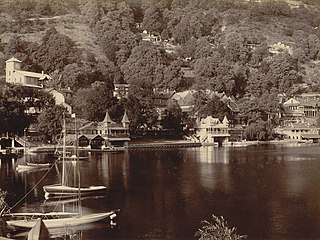
Nainital Yacht Club is a yacht club that was founded in 1910 by the British, and is located at the Boat House Club in Nainital, a hill station in India. Situated along Nainital Lake at an elevation of 2,084 m (6,837 ft), it is the highest yacht club in India and among the highest in the world.
Metropole Hotel is a defunct heritage hotel located in Nainital, Uttarakhand. Built in 1880 by the British Raj, it is the oldest hotel in the city. It is best known for its Nainital-pattern-roofing, a type that uses flat non-corrugated, galvanized tin plates.

















